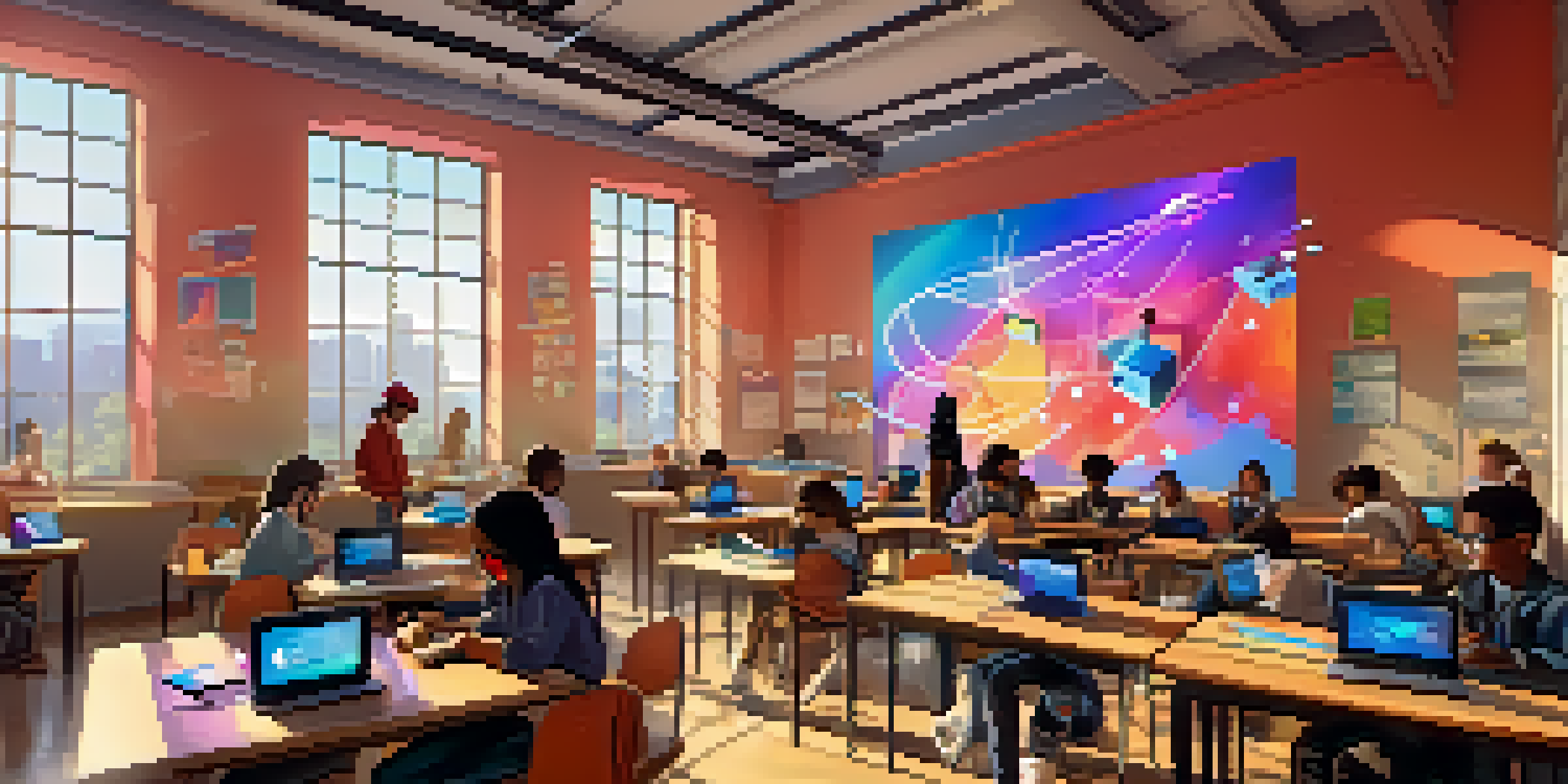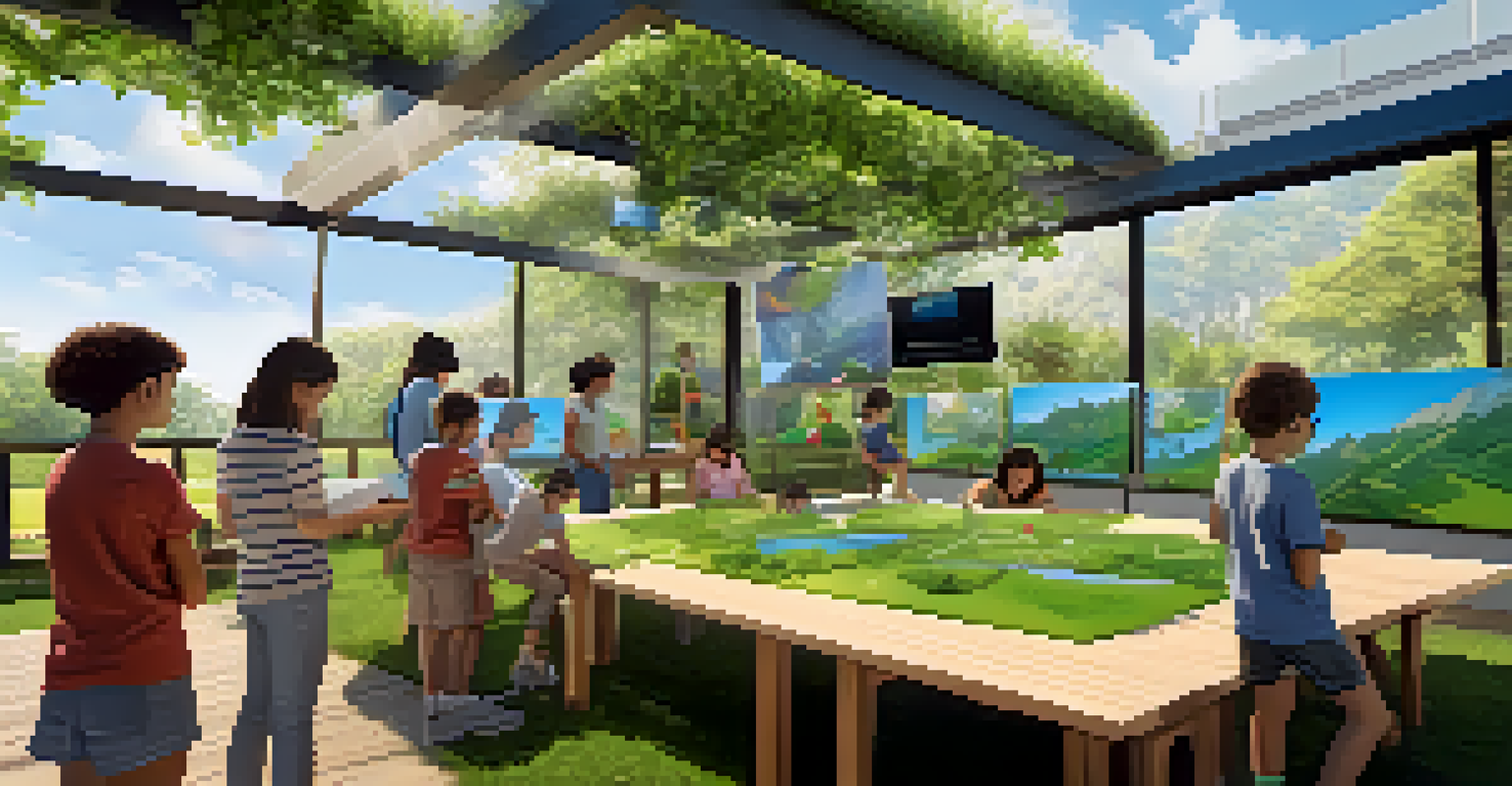Using AR to Teach Programming and Coding Skills

What is Augmented Reality in Education?
Augmented Reality (AR) blends the digital world with our physical environment, enhancing our perception of reality. In education, this means overlaying digital information onto real-world objects, making learning interactive and engaging. Imagine looking at a physical coding book and seeing animated characters explain concepts right before your eyes!
The future of learning is not about memorizing facts, but about understanding concepts and applying them in real-world situations.
By using devices like smartphones or AR glasses, students can visualize complex coding concepts in a more digestible manner. This technology not only captures attention but also fosters deeper understanding through interactive experiences. For instance, a simple code snippet can transform into a dynamic simulation, illustrating its function live.
As AR continues to evolve, its potential in education grows tremendously. It offers a fresh approach to teaching programming, making it accessible and fun for students of all ages. With AR, we can move beyond traditional methods and create immersive learning experiences that stick.
Benefits of Using AR for Learning Coding Skills
AR provides a host of benefits when it comes to teaching coding skills. One of the most significant advantages is its ability to simplify complex ideas. For example, students can visualize algorithms in action, making it easier to grasp abstract concepts like loops and functions.

Additionally, AR can enhance engagement and motivation. When students can interact with their learning material, they are more likely to stay focused and interested. Imagine a classroom where students can manipulate 3D models of their code, testing and tweaking it in real-time—this hands-on approach makes learning exhilarating.
AR Makes Learning Coding Fun
Augmented Reality transforms coding education by making complex concepts interactive and engaging for students.
Moreover, AR supports diverse learning styles. Visual learners can benefit from seeing concepts in action, while kinesthetic learners can engage through interactive simulations. This adaptability ensures that all students, regardless of their preferred learning method, can thrive in programming classes.
Real-World Applications of AR in Coding Education
Several educational institutions and coding boot camps have begun integrating AR into their curriculum, showcasing its real-world applicability. For instance, some organizations use AR to create virtual coding labs where students can practice coding without the fear of failure. These environments allow for experimentation and immediate feedback, crucial components of effective learning.
Technology is best when it brings people together.
Another example is AR-enabled coding games that challenge students to solve problems using code while navigating through a virtual environment. These games not only teach coding skills but also encourage critical thinking and problem-solving, essential competencies in today’s tech-driven world.
These real-world applications demonstrate how AR can transform the landscape of coding education, making it both relevant and exciting. By bridging the gap between theory and practice, AR prepares students for future opportunities in programming and technology.
Challenges of Implementing AR in Education
While the benefits of AR in coding education are substantial, there are challenges to consider. One major hurdle is the cost of technology. Not all schools can afford the necessary AR equipment, which could lead to disparities in access to this innovative learning tool.
Additionally, there’s a learning curve associated with using AR technology effectively. Teachers must be adequately trained to integrate AR into their lessons, ensuring that they can guide students through this new medium. Without proper training, the potential of AR may not be fully realized.
Real-World AR Applications
Educational institutions are implementing AR for virtual coding labs and games, enhancing practical learning experiences.
Lastly, there’s the challenge of content creation. Developing high-quality AR educational materials requires time and expertise. However, as more resources become available, these challenges may diminish, paving the way for broader adoption of AR in educational settings.
Future of AR in Teaching Programming Skills
The future of AR in teaching programming skills looks promising as technology continues to evolve. With advancements in AR applications, we can expect more interactive and immersive experiences for learners. Imagine students coding in a completely virtual environment where they can see the results of their work in real-time.
Moreover, as AR becomes more mainstream, we may see a rise in collaborative learning experiences. Students could work together in augmented spaces, sharing ideas and solutions as they navigate challenges. This collaborative element could further enrich the learning process, fostering a sense of community among budding programmers.
Ultimately, the integration of AR into coding education may reshape how we teach and learn programming. By embracing this technology, educators can prepare students for a future where coding is not just a skill but a fundamental part of everyday life.
Tips for Educators Using AR in Coding Classes
For educators looking to leverage AR in their coding classes, start by selecting user-friendly applications that are easy to integrate into your curriculum. Familiarize yourself with the technology and explore its features before introducing it to your students. This preparation will ensure a smoother transition into AR-enhanced learning.
Consider incorporating AR into existing lesson plans rather than overhauling your entire approach. For example, use AR to visualize a coding concept you’re already teaching, allowing students to see the practical application of their work. This integration can make lessons more dynamic and relatable.
Challenges in AR Adoption
Despite its benefits, implementing AR in education faces hurdles like technology costs and the need for teacher training.
Finally, encourage feedback from your students about their AR experiences. Understanding what works and what doesn’t will help you refine your approach and better meet the needs of your learners. By fostering an open dialogue, you can continuously improve the learning experience with AR.
Conclusion: The Potential of AR in Coding Education
In conclusion, Augmented Reality holds tremendous potential for teaching programming and coding skills. It not only simplifies complex concepts but also engages students in ways traditional methods often cannot. As we continue to explore the capabilities of AR, it’s clear that this technology can make learning to code a more interactive and enjoyable experience.
The journey of integrating AR into education may come with its challenges, but the benefits far outweigh the obstacles. By embracing AR, educators can foster a generation of learners who are not only adept at coding but also excited about the endless possibilities of technology.

Ultimately, AR is not just a trend; it’s a powerful tool that can transform the educational landscape. As we look to the future, the question isn’t if AR will change how we teach coding skills, but how quickly we can adapt to this exciting new reality.